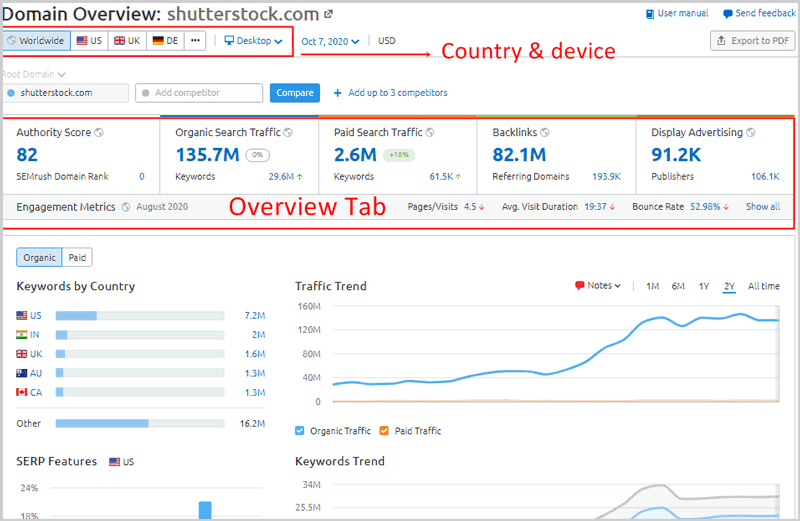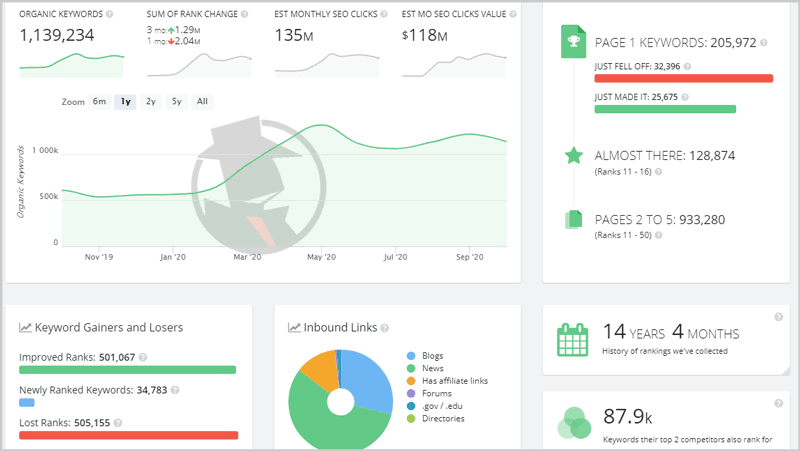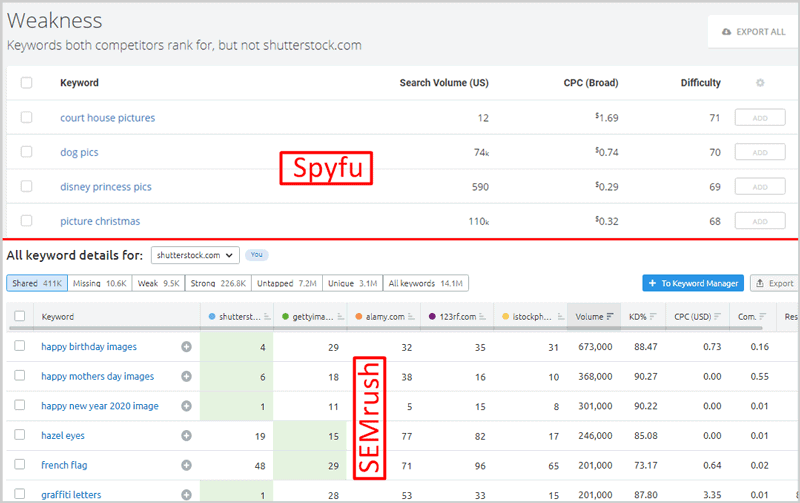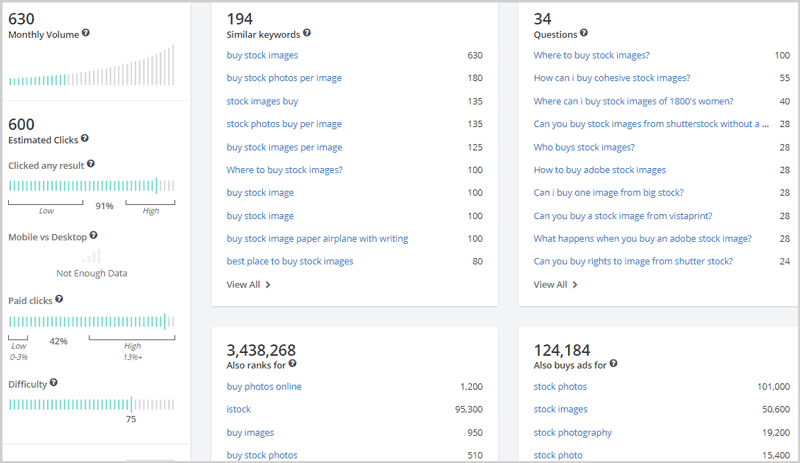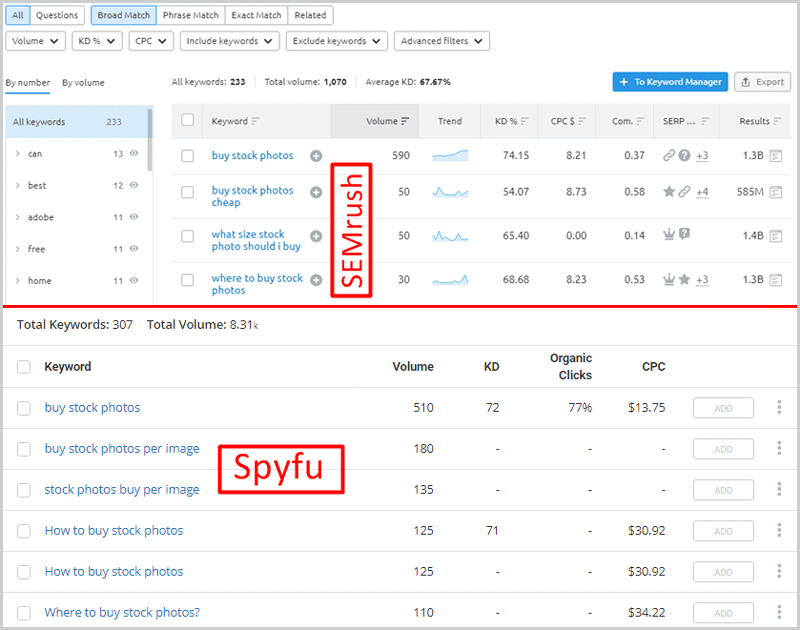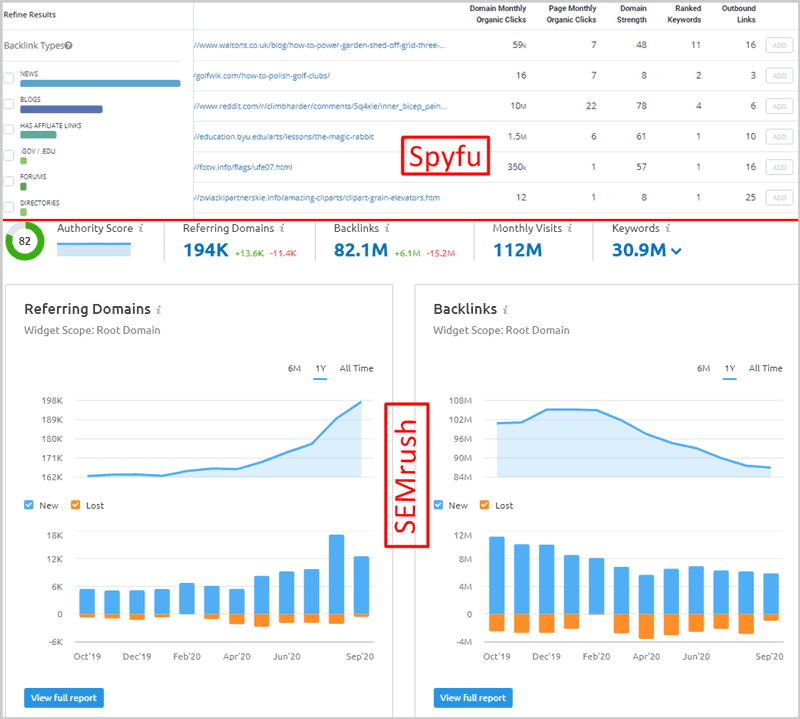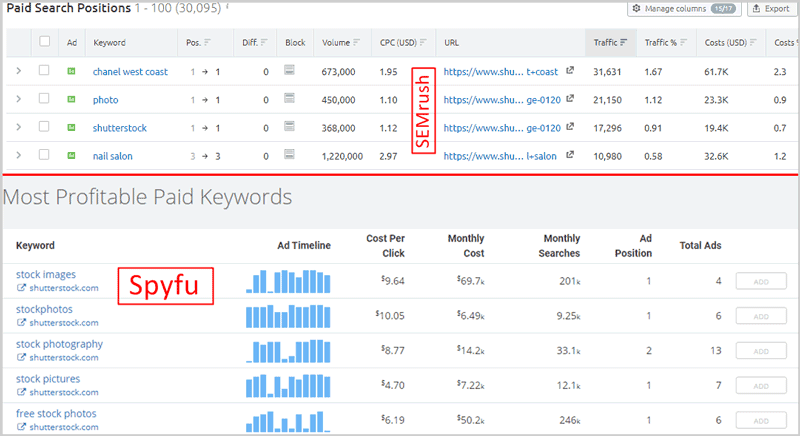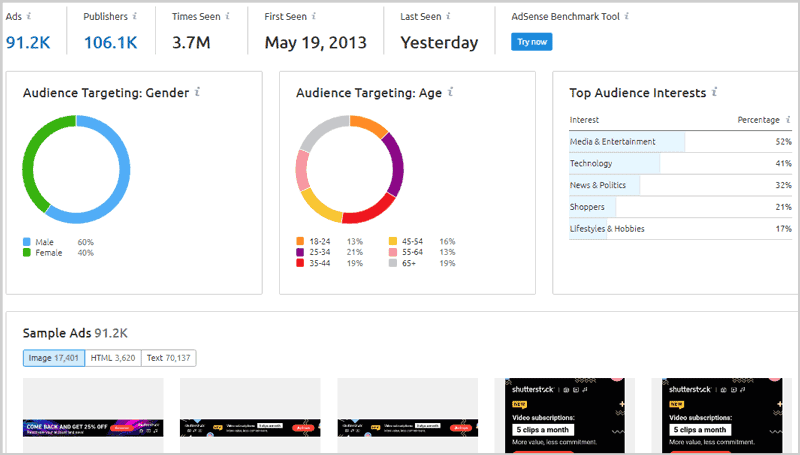Which tool will win if there’s a Spyfu vs SEMrush comparison? What kind of data, how much data, and what other features do each of these tools offer?
Which tool will offer better keyword research features? Maybe, you need to spy on your competitors? Which of these tools makes that possible and to what extent? Building backlinks? Again, should you go with SEMrush or Spyfu?
Those are just some of the factors I’ve discussed throughout this Spyfu vs SEMrush comparison. And hey, I’m not just “making claims”. Each statement is backed by a screenshot, as well as transparent data.
So, you don’t have to take my word for anything! Moreover, SEMrush offers a 100% free trial as well (Link to activate free 14-days PRO trial). Meaning, you don’t have to spend anything before you’re fully satisfied with the services!
So, Spyfu vs SEMrush, which will be the more profitable tool for you and generate a better ROI? Let’s see.
Table of Contents
- SEMrush Domain Overview vs Spyfu Overview
- Spyfu vs SEMrush Pricing Plans
- SEMrush SEO Tool vs Spyfu Competition Research Tool Final Verdict
SEMrush Domain Overview vs Spyfu Overview
What’s the first step of almost any research? An “overview” of the domain/project/website. Isn’t it? I mean, even if you’re checking your own website, or spying on a competitor, an overview is where we start, right?
By “overview”, I mean as much data about a domain as possible, on a single page. Let’s see which tool gets us a better overview then?
SEMrush Domain Overview
I enter a domain onto SEMrush, and it truly gets me almost every bit of data about the domain. Here’s a sneak-peek:
The “Authority Score” is the first metric that’s displayed. It basically tells me how strong the domain is. (Or, how hard it’ll be to beat the domain if it’s a competitor.) It’s calculated based on backlinks, traffic and other such data.
It then shows the organic traffic for the domain and the traffic from paid sources (ads). The number of backlinks follows next.
I love its “Display Advertising” section. This tells me the number of ads being run for the domain and the number of publishers. (I’ll discuss this in detail in the later sections on this Spyfu vs SEMrush comparison.)
Pages/visit, average visit duration, and bounce rate are some of the other metrics displayed just below the overview tab.
Do note that so far I’ve only been looking at the “overview tab”. I can change the data by choosing a different country or device. Data relevant to my selected preferences will then be shown in the overview tab.
Anyway, I must say it’s already pretty detailed. But, the overview page also gives me a lot of other information.
Wish to know how many of your keywords are ranking in each country? How many SERP features are you ranking on? Or maybe, you need a complete list of all your organic and paid keywords? All that’s displayed as well.
And hey, every domain has its own competitors. How about a list which shows all the organic, as well as paid competitors (who run ads for the same keywords). This too is shown.
There’s a “backlink” section which shows me a backlink list, no. of follow vs. nofollow links, type of backlinks, a list for anchor texts, top pages by backlinks, top publishers for the domain’s ads, top landing pages for the domain (ads), and finally, all the banners found advertising for the domain.
In a nutshell? You’ll truly get a very detailed overview of a domain in a few minutes without having to navigate to any other page.
Start SEMrush Free 14-days Pro Trial Now
Spyfu Overview
Spyfu, as you’ll soon see, breaks down data into fragments and parts which makes it easier to understand.
Here’s what an overview page looks like:
So, it tells me the number of organic keywords on the domain along with the total no. of clicks it gets from search engines. It also shows an approximate monetary value for the clicks.
Then, there’s a chart showing organic vs. paid clicks. On the right (in the screenshot above), you can see it shows the number of paid keywords and the estimated PPC (paid) clicks.
Isn’t it almost magical that it also shows me the date of the first-ever organic ranking for the domain, as well as the first ever Adword ad? This helps me understand how old the domain is, and how long it has been buying ads.
Furthermore, a very neat graph also shows me the number of keywords that “just made it to the first page” and those which just “fell off the first page”.
Below that, just like SEMrush, there are two lists. One shows me my organic competitors, the other lists my paid competitors.
Next is the “Competitors” section on the overview page. It shows me a Venn diagram of my top 3 competitors.
It’s neatly broken down into sections such as “keywords all domains rank for”, “keywords any domain ranks for”, “keywords my competitors rank for but I don’t”, and keywords only I rank for and my competitors don’t.
On the right (in the screenshot above) is the paid-ad data for these competitors. It tells me the number of common keywords all 3 domains buy ads for, keywords any domain (one or more) buys ads for, keywords both competitors bid on but my domain doesn’t, and finally keywords only my domain bids on and the other two domains don’t.
Then, there’s a list showing me my top organic and paid keywords. No. of clicks (traffic) for the organic keywords and monthly cost (for the paid keywords) too is mentioned.
Then comes a list of the top pages for my domain. What’s unique is Spyfu’s “top Adwords buy recommendations” . These are keywords 5 of my competitors are buying ads for but my domain isn’t.
That’s not all! Spyfu even pulls ad-copies (Adword ads) that each of these 5 competitors run. The coverage (impression: searches ratio) as well as the CPC and clicks/month for each ad too is displayed!
Then, there’s a backlink list. The traffic on each domain, domain strength, ranked keywords and outbound links from each domain too is mentioned.
Hey, I’ll be honest. It does seem like Spyfu shows “more” data than what SEMrush’s overview page displays. But, remember that all of this data is also available with SEMrush. It’s just not displayed on the “overview” page.
Moreover, Spyfu’s overview page is designed such that almost all the features that Spyfu offers, are presented as a section/widget on the overview page. Hence, the “more” data that you see.
But, SEMrush only presents a fraction of its features on the overview page. However, beyond excuses, because we’re talking of an “overview”, Spyfu totally offers more data than SEMrush (as far as an overview goes).
Spyfu Kombat vs. SEMrush Keyword Gap
Spyfu markets itself as a “competition research” tool. So, let’s talk of that for a moment?
Spyfu has a feature called “Kombat”. This is the competition research tool provided for keywords. When you enter a domain, 2 other domains are automatically added for comparison. These two are your biggest competitors. Obviously, you can manually enter two domains as well.
It shows you “keyword comparisons”. Meaning, common keywords between the three domains, keywords exclusive to your domain, and keywords the other two domains rank for by your domains doesn’t.
The monthly search volume, CPC and difficulty for each keyword is displayed as well. Do note that there also is a “Paid Kombat” feature which shows keyword comparisons for “paid” keywords.
Similarly, SEMrush has its “Keyword Gap” feature. Unlike Spyfu which only lets you compare your domain against 2 other domains, SEMrush lets you add 4 more domains in addition to your domain for comparison.
Also, SEMrush’s Keyword Gap lets you select a geo-filter (country) for which you wish to compare your keywords. Spyfu doesn’t offer any country-selection, rather, it checks U.S rankings by default.
SEMrush displays the search volume, difficulty, CPC, paid-ad competition and total no. of results for the keyword on search engines. This again is comparatively more data than what Spyfu displays.
Moreover, while SEMrush and Spyfu both display paid-ad keyword comparisons, only SEMrush offers the ability to compare the domains for their PLA (Product Listing Ad) keywords.
In a nutshell, SEMrush’s Keyword Gap is way better than Spyfu’s keyword Kombat.
Spyfu Keyword Research vs. SEMrush Keyword Research
So, you have a broad keyword (seed keyword/niche) in mind? What other details, metrics, additional keywords do each of these tools show you for your keyword? That’s what this next section is about.
Here’s an overview of what Spyfu shows me when I enter a keyword on its keyword research page:
The search volume, similar keywords and question-keywords are pretty traditional. However, it also shows a “total clicks” metric. This is the total of all the clicks made for this keyword on Google in the past 30 days.
Additionally, the “clicked vs. not clicked” percentage too is displayed. So, you know if users searching for this keyword actually click on results, or, the SERP features and other factors steal your clicks.
It also shows how many of those searches are from a mobile device vs. desktop. Furthermore, the percentage of “ads” getting clicked for the keyword too is mentioned.
The other standard data that’s displayed includes the CPC and SERP features available for the keyword.
However, it’s impressive because it considers the volume and CTR, and tells you the monthly cost for running ads on the keyword.
There’s more! Would you like to know the number of advertisers running ads for the keyword? Let’s go a bit farther, how about the complete list of advertisers, their monthly budget, total keywords, and even exact ad copies for the ads! Yes, that’s possible.
It also shows the number of “homepages” ranking for the keyword instead of “pages”. The top 10 SERP results, changes in their position, domain strength and clicks from the keyword for each domain too is displayed.
All in all, it’s pretty impressive so far, isn’t it? Let’s see SEMrush’s keyword research then? After all, this is a Spyfu vs SEMrush comparison, isn’t it?
This is SEMrush’s keyword research page:
Again, SEMrush lets me check country & device-specific (mobile/desktop) data. Spyfu has no such feature.
It displays the volume for the country I’ve selected, and also the global volume. Volume for other countries too is displayed.
Obviously, the keyword difficulty and CPC too are shown. What’s impressive is, SEMrush also shows a “.com” metric. This is the “paid competition” on the keyword. Spyfu doesn’t show this metric.
The total number of results in SERP, the available SERP features for the keyword, number of ads and PLA (this again is something that Spyfu misses) ads too are displayed.
Then, it shows a list of keywords containing keyword variations, questions, and related keywords. So, your “seed keyword” will help you get more keyword ideas. You can either use these within your content, or find related but low-competition keywords altogether.
And, finally, the top 10 SERP results, their AS (Authority Score), traffic, no. of backlinks, referring domains etc. are shown.
Remember how Spyfu got us ad-copies for the keyword? Well, SEMrush does that too! It not only gets us the ad-copies for Adwords, but also PLA ads which Spyfu doesn’t.
Overall, I personally prefer SEMrush’s keyword research much better. While Spyfu seems to display ‘more’ data (again), the lack of control over countries and devices is an obstacle for me. (Keywords have massive volume, CPC and difficulty-differences just based on their countries, right?)
Also, SEMrush provides nearly everything that Spyfu does. So, there’s no extra Spyfu perk that I seem to be missing with SEMrush.
Spyfu Related Keywords vs SEMrush Keyword Magic Tool
Both of these are additional “keyword research tools/features” that the tools individually provide. They help me find “new or more” keywords similar to my seed keyword.
First off, I must say Spyfu again doesn’t offer any geo-filters. So, I can’t filter the data for specific countries or devices. I can do so with SEMrush.
I searched for “buy stock photos” on both the tools. On SEMrush, I limited the results by selecting “U.S” as the geographic location, while no limitations/filters where applied on Spyfu.
Here are the results from both the tools-
First off, note that SEMrush still got me 233 ideas with a total monthly volume of 1070 even though it had been restricted to “U.S” data. On the other hand, Spyfu got me 307 keywords globally.
Then, the difficulty and “organic clicks” metrics are often unavailable with Spyfu. However, all the keywords have all the metrics available to them with SEMrush.
Moreover, SEMrush also displays the SERP features, total results and the “paid competition” for each keyword. These are metrics which Spyfu misses.
These are the prime reasons why I believe SEMrush offers better keyword research features than Spyfu.
SEMrush vs Spyfu Backlink Research
Spyfu offers two modes of backlink research. Let’s first start with the traditional mode? So, you can enter any domain for which you wish to check the backlinks.
It then displays all the backlinks, monthly organic clicks to the page, domain strength, outbound links from the page and ranked keywords for the page. All this data is displayed for the link-source.
SEMrush on the other hand offers a much more detailed insight into a domain’s backlink profile.
SEMrush shows you the total referring domains, total number of backlinks, monthly visits to the domain (your domain), and total keywords on your domain.
It then has graphs which show you the new vs. lost backlinks over time. Similar graphs are available for the changes in the number of referring domains.
Furthermore, categories of the backlinks, exact anchor-texts, percentage for each of the anchor-texts, RDs cateogrized by authority score, types of links (text/image/frame/form) and link-attributes too are shown.
SEMrush also shows the top countries which send out these backlinks, TLD distribution, pages with the most number of backlinks etc.
Spyfu completely misses out on all these details. There’s absolutely no “total number of links” or RDs, no anchor-text information, no link types/attributes are mentioned either.
All in all, I’d say the backlink research feature on Spyfu is not just “not impressive” but is disappointing.
Backlink Competition Research
Which links do your competitors have which your domain missed? That’s what this feature allows you to find.
Now, SEMrush has a dedicated “Backlink Gap Tool” to make this happen. On Spyfu though, there’s only a “filter” on the backlinks page.
It lets you add a domain (or, many domains) and then add your own domain. When enabled, this filter will only show the links which the other domains have but you don’t.
Here’s what the results look like on Spyfu:
Well, it’s the same thing as a standard backlink research. It only displays the links you don’t have. Simple, eh?
On the other hand, SEMrush, as always, gets us a lot more data:
So hey, I totally get the links that my domain doesn’t have. But, it also allows many other filters. Such as, links unique to me, links common to all the domains, links that only 1 of the 5 competitors have etc.
So, again, I guess it’s clear why I believe SEMrush to be the better backlink research and backlink competition research tool than Spyfu, isn’t it?
Automated Best Links Finder
This is another feature that both SEMrush and Spyfu offer. In simpler words, if you’re completely clueless about which links to build, this is for you.
These SEO tools show you exactly which links to build in order to rank for a keyword.
On Spyfu, I just enter a keyword, and it shows me a link of the most profitable backlinks I should go for.
SEMrush has a much more advanced “On Page SEO Checker”. A part/section of it shows me this list of backlinks which I should build in order to rank that specific page.
So, while it’s a feature with Spyfu, it isn’t missing with SEMrush either.
SEMrush Position Tracker vs Spyfu Tracking
Another major feature both the companies provide is rank tracking. Hence, obviously, this Spyfu vs SEMrush comparison can’t be complete without discussing that, in detail, right?
Here’s a comparative screenshot which will help you compare both the tools easily:
On Spyfu, I get the CPC, search volume, estimated clicks and the change in them, and then, obviously the current rank and change in the rank.
On SEMrush however, I get all the metrics that Spyfu is offering. Additionally, it also shows the SERP features, visibility and the exact ranking URL. All these metrics are missing on Spyfu.
Hence, again, I guess it’s fair to say SEMrush offers a better rank tracking feature than Spyfu.
Paid Ad Research
Spyfu markets itself heavily on being able to pull paid-ad data for any domain. SEMrush too offers a complete toolkit called the “Advertising Toolkit” for ad-data.
However, Spyfu is limited to “PPC” data. While SEMrush also offers advanced features for spying on PLA ads, and Display Advertising.
Hence, without doubt, SEMrush already is a winner as far as the Spyfu vs SEMrush ad-database goes. However, let’s compare the PPC data which is common for both the tools.
Spyfu will first of all show the total number of paid keywords on the domain. Then, it shows the estimated monthly traffic (from paid ads), and the monthly PPC budget.
SEMrush too displays the exact same metrics as far as an overview goes, i.e. the total number of keywords, traffic and traffic cost (budget).
The prime attraction is the keyword and ad-list from both the tools. Spyfu displays the keyword, URL for the ad, CPC, monthly cost, total number of ads, ad position, and monthly searches for the keyword.
SEMrush on the other hand displays the current position of the ad + the change in position. It also shows the “percentage” of the cost for each keyword, out of the total ad-budget. The other metrics are all available including the CPC, volume, traffic, URL etc.
Hey, what of your ad-competitors? Well, Spyfu does have a “competitors” section on the same page. But, it only shows the number of ads, number of clicks and budget for each domain.
SEMrush on the other hand shows the “paid-ad competition” level (with your domain) for each domain. It also shows the common keywords, organic keywords, paid traffic and its budget for each domain.
Both the tools do display the actual ad-copies for each domain. However, overall I’d say SEMrush offers a lot more data than Spyfu.
I say that also because Spyfu completely lacks “Display Advertising” and “PLA” ad data. While, with SEMrush, you get full access to the exact banners used for display advertising, the full list of publishers (of those banners), and even audience demographic (age/gender/device and country).
Similarly, SEMrush also shows you the exact PLAs (Product Listing Ads) used by a domain, a full competitor list and ranking positions for the PLAs.
So yes, SEMrush wins this round as well on this Spyfu vs SEMrush fight.
SEMrush Exclusive Features
Apart from the differences mentioned above, SEMrush also offers a number of features which Spyfu lacks. Let’s discuss them in brief?
- Backlink spam/toxicity detection: SEMrush shows you a complete list of potentially spam backlinks. Spyfu doesn’t. Would you risk getting penalized? I sure wouldn’t.
- Content Marketing Toolkit: This feature helps even the most clueless of beings find a profitable topic, write a well-optimized article, build the right backlinks, market it the right way and ultimately rank it! It’s so advanced, I did a complete review of the SEMrush Content Marketing Toolkit.
- PLA and Display ad data: As discussed above, Spyfu completely missed these.
- SEO Writing Assistant: Not fluent in SEO? You don’t have to be. SEMrush literally guides you after each word, in real-time, and gets your content perfectly optimized.
- CPC Map: Tells me the highest and lowest CPC keywords for specific countries/regions.
- Site Audit & On page SEO checker: SEMrush also has a very detailed on page SEO feature. (It truly is extremely detailed. Read more in my in-depth SEMrush review). Spyfu doesn’t offer this either.
- Plagiarism checker: SEMrush also includes a plagiarism checker with its writing assistant.
Now, if I’m being honest, there’s literally no feature that Spyfu offers but SEMrush doesn’t. So, those are pretty strong reasons why I love SEMrush, right?
Spyfu vs SEMrush Pricing Plans
Both the tools are feature-rich. Obviously. But, you can’t sell a Toyota for the price of a Mercedes, right? So, let’s see what these tools are demanding, and if the prices are rightly quoted.
Well, SEMrush seems to be pretty confident of its capabilities. This is probably why it offers a 100% free, 14-day trial. Well yes, you get complete and full access to all the features, without paying a penny.
Start SEMrush Free 14-days Pro Trial Now
Even after the SEMrush trial ends, you get to use SEMrush free forever. Obviously, with limited features!
If you do like SEMrush though, there are three paid plans:
- Pro: $99.95/month
- Guru: $199.00/month
- Business: $399.00/month
As for Spyfu plans, they’re as follows:
- Basic: $39.00/month
- Professional: $79.00/month
- Team: $299.00/month
Now, it certainly is the cheaper solution.
But, hey, do you wish to save money, or make more money with the right tools? There’s a difference. I may be a bit biased (because I’ve been using SEMrush for nearly half a decade now), but, in my opinion, I do think SEMrush is priced pretty rationally.
SEMrush SEO Tool vs Spyfu Competition Research Tool Final Verdict
Let’s wrap this Spyfu vs SEMrush debate?
If I’m being completely objective, after using both the tools extensively, SEMrush without doubt comes out on top.
I mean, it just offers a lot more data, a bigger database, and more features. If you still aren’t sure, do peek at my Semrush against Similarweb comparison. You’ll get a more diverse idea of its potential.
But hey, let’s be honest, Spyfu’s primary focus is on “competition research” and “Adwords”. Hence, it’s a bit unfair to compare it to a SEMrush.
So, you totally can go with Spyfu if you’ve a lower budget, and you do not need data as extensive and detailed data as SEMrush provides.
But, you may have a small “blog” today. It doesn’t take a lot of time for it to become a full-fledged business. Hence, isn’t it better if you get a solid footing right from the start?
But hey, don’t take my word for anything. Go try SEMrush for 14 days yourselves. It’s 100% free. So, you aren’t losing anything, are you?
Start SEMrush Free 14-days Pro Trial Now
For now, let’s just conclude this Spyfu vs SEMrush debate in favor of SEMrush.
